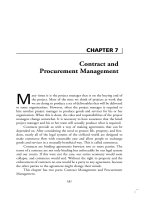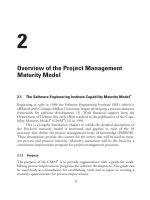Chapter 7: Persuasion Strategy Choices doc
Bạn đang xem bản rút gọn của tài liệu. Xem và tải ngay bản đầy đủ của tài liệu tại đây (245.18 KB, 18 trang )
Chapter 7
Persuasion Strategy Choices
Outline
Persuasion Strategies & Definitions
ACE Model
Role of Introductions
Planning for Obstacles
Communication Issues
Credibility & Evidence
Role of Trust
Maintaining Face
Persuasion Strategies & Definitions
The text (pages 95-99) lists sixty-four
conceptually distinct strategies developed by
Kellerman & Cole (1994 Communication
Theory)
Also known as compliance-gaining strategies –
how to get people to do things they might not
otherwise choose to do
Strategy categories are typically developed to
reduce complexity and simplify choice
•
Threat, orders, rigidity, caution,
ACE Model
Simplify strategies by categorizing in terms of type of
appeal
•
Emotional
•
Reasoning
Types of Reasoning Appeals (ACE)
•
Appropriateness
•
Consistency
•
Effectiveness
Appropriateness Appeals
Involve the application of social
pressure
•
Example - One of your friends
calls you to meet her at a bar
later this evening. You tell her
you have too much work to
complete and need to study for a
test.
•
She says, “But…all of our friends
will be there…you have to go!”
May be more effective with
younger people – those who want
to be liked and admired by
others.
Consistency Appeals
Pertain to what a person like
himself (or like the type of
person he aspires to be) would
do.
•
Example – You are shopping with a
friend who needs to purchase a suit
for an upcoming interview with a
company. Your friend is torn
between two suits – one more trendy
or contemporary and one that is more
traditional.
•
You attempt to persuade saying, “I
think you should buy the more trendy
suit – after all, it really reflects your
artistic and creative side and will
help you be distinctive.”
May be more effective with
people who are more
individualistic and have “minds of
their own”
Effectiveness Appeals
Relate to actions that will help
bring about a result the person
desires
•
Example – A sales rep with Office
Depot presents a plan to your
university purchasing group to enable
their administrative staff to place
orders for office supplies on-line
rather than using the catalog and
purchase orders. The purchasing
manager says “I feel more comfortable
with our current system.”
•
He responds, “I really think this option
will enable you to cut costs. In
addition, your departments will
receive their products quicker and you
can track all purchases on-line. Why
don’t we try it?”
Work best when the larger issue is
less personal, more focused on
attaining the desired result.
Role of Introductions
Once a negotiator has determined the type or category of
appeal to utilize, they must decide whether to use an
introduction or provide some type of post-appeal explanation.
•
Progressive strategy – lead up to a request with a “pre-
solicitation sequence that unearths or deflects sources of
resistance”
•
Regressive strategy – persuader follows a direct request with
explanations for the request and inducements for compliance
Achievers may be more likely than Mediators to take a
regressive approach
Motivators may lead with encouragement and attractive images
Analyticals may be inclined to lead with data
Planning for Obstacles
Identify possible obstacles or objections to appeals
and utilize this knowledge to select strategies
Adapt your appeal in anticipation of the obstacle or
objection you expect to encounter
Potential Obstacles
Inadequate resources –
“Our staff doesn’t have
the capabilities”
Possession – “We don’t
have the funding right
now”
Imposition – “We’re too
busy to do that”
Inappropriateness – “It’s
unethical for you to
request that”
Source responsibility –
“That’s not our
problem”
No incentive – “What’s
in it for me?”
Recalcitrance – “I won’t
do that”
Postpone – “We’re not
ready right now”
State of mind – “I’m too
stressed to do that”
Responses to Obstacles
Acknowledge the Obstacle (Objection)
Assess – ask a question to learn more about the
counterparts’ concern
Respond – use proof statements, testimonials,
benefits, etc.
Seek agreement that you’ve addressed the concern
before you proceed
Managing Obstacles
Managing Obstacles
•
Watch out for cues that obstacles are emerging
•
Pause
•
Identify the source of the obstacle
•
Redirect the process before they loom large
Skilled negotiators seek to avoid or manage
obstacles
Communication Issues
The type of medium with which to communicate is an
important consideration. The more significant the
issue, the more negotiators should rely on media
which allow both verbal and visual interaction
Use of e-mail
•
Consider cultural differences – preference for face-to-face
interaction
Face-to-face and/or video conferencing
•
Provide more cues than fax, telephone or e-mail
If negotiations are of the distributive form, it’s more
important to have multiple communication cues
Credibility & Evidence
Objective Criteria
•
Information that informs a choice but is
independent of the will of either side
•
Present only your strongest evidence
•
Plan for most appropriate timing
Subjective Criteria
•
Useful when counterparts are emotionally
involved and may discount objective criteria or
other rational arguments
Role of Trust
Trust - the willingness
to rely or depend on a
relationship partner in
the context of
uncertainty
•
Based on the actions of
the other relationship
partner in the early
stages of relationship
development
Dissolution
Exploration
Expansion
Commitment
Awareness
Threats to Trust
Breach of trust or defection – one or more parties
violate a trust
Miscommunication – interpret words differently or
misread nonverbal cues
Dispositional attributions – refer to a person’s
character and intentions
Poor pie expansion – failure to expand the pie or seek
a “win-win”
Egocentrism – viewing one’s own actions as good and
worthy and the tendency to view others in less
favorable terms
Reputation
Maintaining Face
Face defined: “the positive social value a person
effectively claims for himself by the line others
assume he has taken during a particular encounter”
Facework – communication that supports or
challenges a particular line
Negotiators should try to maintain the other side’s
face
If negotiations are threatened by loss of face, it will
be difficult to move toward an effective outcome
Strategies to Recover Face
Admissions of fault or shared fault
Denials of intention to harm
Acts of omission rather than commission
Blaming slippage on lack of sleep or misunderstanding
Silence or delaying tactics









